Tags
I’ll probably regret sharing this with you, but I started my working life as a florist. Okay, so I started my working life manning the front counter at McDonalds but since I got fired after two days I don’t think that counts. No matter how proud I am of that achievement. And I have an excuse for the florist thingy. At that time I had a girlfriend – yes, a real vagina – who attended a different high school than I did. Several of the area’s school districts joined together to offer vocational classes for seniors during the last three hours of the school day. She wanted to take the floral training block, and by my signing up too we got to spend part of our school day together. Awwww. Young love. The class was a success, our relationship not so much. She went on to become a mortician. And I went on to become gay.
Those classes were only a semester long. BUT, if you landed a job in that field you got credit for your employment and could go to work rather than school. So I did. I could simply say the rest is history and get on with the point of this post, but instead will tell you the florist business is one of feast or famine. On major flower giving holidays biz is blooming and demand is so great you could wrap up the weeds growing in the vacant lot across the street and desperate men would still buy them. Which I also did. You may be getting a small idea of why I lost that job at McDonalds. Outside of the holy flower giving days, bidness is dead. I don’t mean there is no business; there is. But you spend your days creating lovely works of floral art for dead people. ‘Cuz people feel obligated to send floral tributes to the dearly departed almost as much as guys do on Mother’s Day.
You wouldn’t think morticians have much of a sense of humor, but ya gotta find your laughs where you can. The first delivery I made to a funeral we were handling was one of those times. Everything was running smoothly until I got to the corsage the corpse’s family had ordered for the body and the funeral director told me it was my job to put it on the stiff. Yuk. I don’t like getting that close to old people even when they are still breathing. But I took a deep breath and then spent several minutes trying to pin the corsage to her blouse without getting dead tit. Much mirth among the funeral staff ensued. Finally one of the staff came over, lined up the corsage in perfect position, and then jabbed the corsage pin directly into her body to hold the flowers in place. Yup, that’s how they do it. So you may want to skip the corsage when your mom passes on. Or if you are not real fond of her, reserve the right of pinning on her corsage for yourself.
As much as I enjoy checking out wats in Thailand, and as often as those wats feature dead people and/or bits and pieces of the dead Buddha, even I acknowledge there are other attractions worthy of a visitor’s time. I have a long list of places I’ve heard or read about that, some day, I want to take in. That list just keeps getting longer. At the rate new shopping malls are being built in Bangkok, those alone could keep me going for decades. So I rarely get around to checking out the places that have been waiting at the bottom of my list for years. On my most recent visit I decided to force myself to take in a few of those perennial must-dos. One of which – and I’m not sure why it ever made it to my list – was Bangkok’s Museum of Floral Culture. Maybe it was my years of toiling in the industry. Maybe it was because I’m a gay man. Maybe it was because it sounded better than The Sea Shell Museum. If you are a first-time visitor to Bangkok, I wouldn’t suggest the Museum of Floral Culture as part of your itinerary. But if you are a frequent visitor and are looking for something different to do, the museum makes for a tranquil outing for an afternoon.
The brainchild of internationally known floral artist Sakul Intakul – who is also the florist to the Thai royal court – the museum is set in a 100+ year old colonial-style two-story teak house built in 1920 by one of the officers of the palace guards, who was granted the land by the king. If you go on a weekend, Sakul is available to answer questions (and autograph his book), and just in case you were thinking that all floral designers are gay, after meeting the man you’ll quickly realize that is probably not just a stereotype. Opened in 2012, the museum is dedicated to the floral arts with an emphasis on their use in Thai art and culture. So it’s a bit of surprise that the one thing the museum is lacking in is flowers. Fresh blooms are few and far between. Your hotel lobby probably has a more massive display. The museum is more a tribute to the art of floral displays than a display of floral art. But then museums are (I’m told) supposed to educate, and in that task Sakul’s creation excels. And it still beats visiting Jim Thompson’s House of Silk for Sale hands down.
Located in a quiet residential area of Dusit district, the museum sits in a beautifully landscaped Thai-meets-Zen-style garden featuring shrubbery and trees planted in auspicious locations in accordance with ancient Thai beliefs; kind of a Thai geomancy version of feng shui for the garden At one time locals paid strict attention to what vegetation was planted in their gardens and where each type of tree or plant was located, all of which (when done properly) brought good fortune and luck to the residence. Nowadays, not so much. But the museum’s guides takes great care to explain the concept and it’s not a part of Thai culture you are likely to learn about elsewhere.
Inside the house, each room serves as a different exhibition space. The first, the Dusit Gallery, displays photos of key members of the Thai court who helped to cultivate the Thai art of flower arranging during the reign of King Rama V. The World of Floral Culture is in the next room and features photos and plastic arrangements of floral displays used in festivals and ceremonies of Bali, India, Japan, Cambodia, Laos, and Tibet. There are two Heritage of Thai Flower Culture rooms, the first deals with the history of flower arranging in Thailand with a focus on how flowers, petals, leaves or other part of plant materials are sewn, pinned, weaved, tied, and folded to fabricate different forms of Thai floral art. Part II is all about banana leaves and how they are manipulated to create special offerings for the gods as well as Krathong floats. These two rooms were probably the most interesting of the tour as they dealt with the traditional styles of Thai floral arts.
There is another room or two on the tour (tours are mandatory, you can’t stroll through the museum on your own) and upstairs is an exhibit where Sakul shows you the drawings he makes in preparation for his creations, including his work that graced the state banquet tables at the Grand Palace for the 2006 celebration of King Bhumibol’s 60th anniversary on the throne.
None of which probably has you chomping at the bit to make the trek out to the Museum of Floral Culture. But wait! There’s more! As dull as the museum may sound, I would strongly recommend a visit for several reasons, all of which have to do with the experience rather than the attraction. And with a gay man in charge of things, you know parts of that experience are gonna be fabulous. First is getting there. It really is off the beaten path. You can take a taxi and hope for the best. But I’d instead recommend taking an orange flag river boat all the way up the Chao Phraya to Pier 18 (Payap) which will cost you a whopping 15 baht. That’s about a 45 minute ride from Central Pier and is an excursion in itself. From the pier it’s about a 15 minute hike to the museum through a mostly quaint residential section of old Bangkok, or you can catch a taxi (50 baht, 5 minutes).
One of the things that made me fall in love with Thailand when I first visited decades ago was the warmth and friendliness of the Thai people; there was a reason the country was known as the Land of Smiles. Nowadays, not so much. If you want a touch of that graciousness, a visit to the museum alone is worth the experience. The staff is wonderfully warm, welcoming, and interested in you. It’s as though along with the 100-year-old residence they’ve decided to put on a display of ancient Thai hospitality. Or maybe it’s just that several staff members are gay and recognize that quality in others. In any case, their friendliness is a major part of the experience.
The tour itself, which takes about 45 minutes – of which you’ll spend 40 minutes trying to decipher your guide’s attempt at English – is nothing to write home about. And you are not allowed to take photos inside of the house. But at the end of your tour it is suggested you stop to have tea and desserts on the open-air veranda: it will be the highlight of your visit. Whiling away another hour kicked back in colonial splendor is the perfect way to spend an afternoon at the museum; the Dok Mai Salon du Thé (finally) has fresh, beautiful flower arrangements adding to its ambiance and the salon is a perfect fit for the romantic atmosphere of this classic teak house.
The tea selections are all floral-infused and selected by Sakul. Try the Kathmandu Cinnamon Apple, a lively, fresh blend dominated by a delightfully aromatic burst of sweet and spicy cinnamon with a hint of juicy apples. A pot of tea runs 120 baht, or you could – and should – order the 240 baht set which comes with a selection of six exquisite Thai confectionary sweets. Not only do they look sumptuous, but they taste just as good, which may be a bit surprising at first if you are not familiar with Thai desserts.
As an added bonus, this year on the second Saturday of each month a special flower workshop is being held. Each session is limited to 12 participants (so book in advance) and each month the session covers a different subject such as the art of lotus petal folding, making a traditional pointed dome arrangement from jasmine blossoms, and stringing traditional flower garlands. Each course runs from 10am to noon and includes tea and sweets at a cost of 1,700 baht. Which may sound a but pricey, but at least you won’t have to do a vagina to gain some flower arranging skills like I did.
The Museum of Floral Culture is open from Tuesday to Sunday, 10.00am to 6.00pm. Guided tours are conducted in English at 11am and in Thai at 2pm and 4pm (although you may be the only people in your tour and then the language will be fit to your preference). Tours last for 45 minutes, but can easily stretch into an hour or more if you have lots of questions or just want to enjoy the house and grounds at a leisurely pace. Admission is 150 baht.
| Related Posts You Might Enjoy: | ||


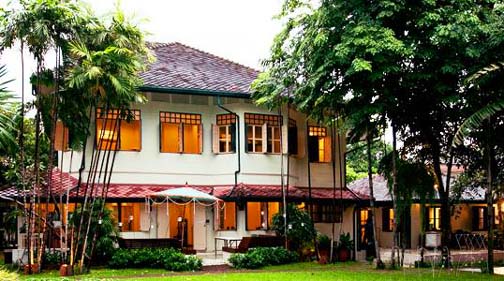
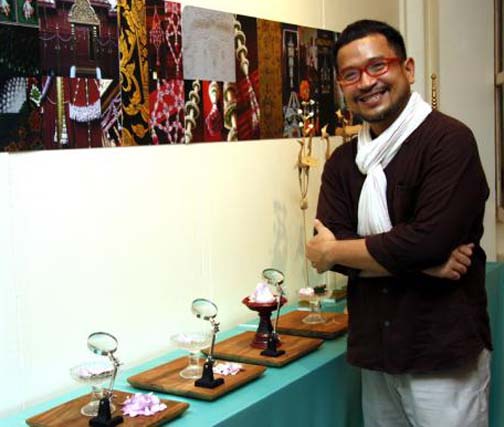
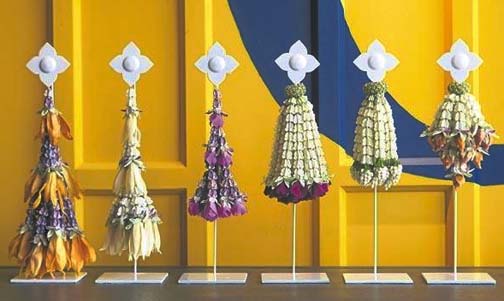
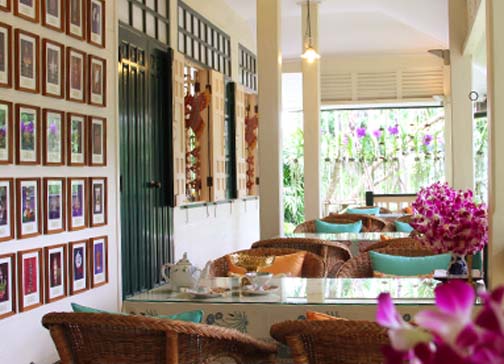
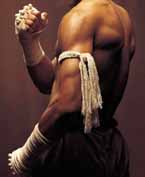

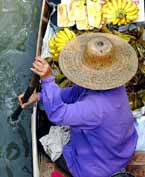
Your writing reminds me at times of two loud, very flamboyant floral designers buddies, so I’m not surprised about your work history. I’m sure you do pull off wearing a white chiffon scarf with matching pants better than the guy in the third photo.
Thai schoolchildren learn early on to make the flower garlands (phuang malai พวงมาลัย for Christian). Must be more fun than reading, writing & arithmetic, since Thailand’s education is ranked eighth in the 10-member ASEAN by the World Economic Forum.
One Thai friend periodically gives me her folded pandanus leaf creations (bai toey ใบเตย for Christian). They look like they take hours to make, but she enjoys it. These aromatic leaves are used in Thai cooking as well.
Christian probably knows “Dok Mai” ดอกไม้ is Thai for flower! 😉
On a visit to Chiang Mai, Pom and her girlfriend gave me a black scarf as a birthday present one year. Incredibly nice gesture and totally unexpected, but it was a bit too long to use to tie Noom to the bedposts so I’ve never had a use for it. Guess I need to buy some black jeans and then I’d be stylin’.
And I’m sure Christian knows Dok Mai means flower. I’m also sure he uses it in one of his standard pick-up lines.
🙂
Maybe it rhymes with “skin temperature” in German.
🙂
Looks great! Where is it? Will drop by for tea next time. Will you find it odd to know that I can actually tie those flowers? And also carve some mangoes? Gosh am I gay or what!
Huh. Mango carving . . . that does sound gay.
🙂